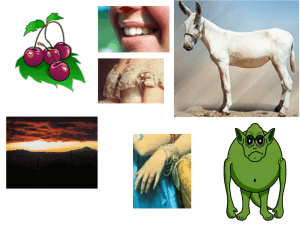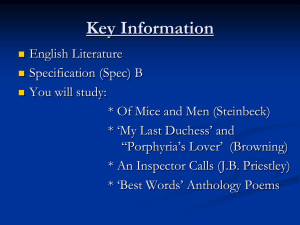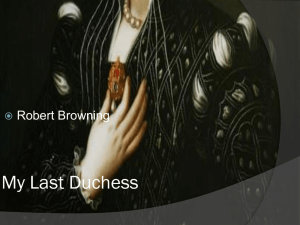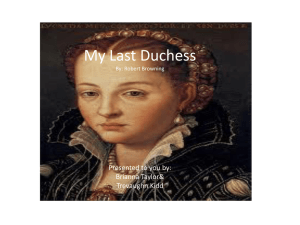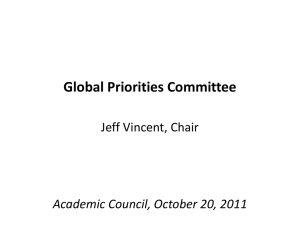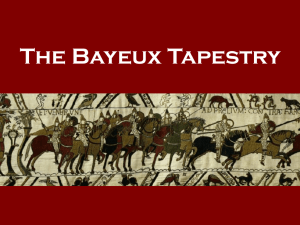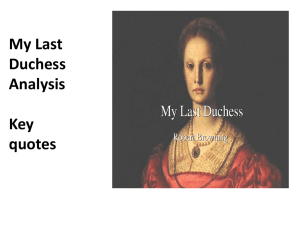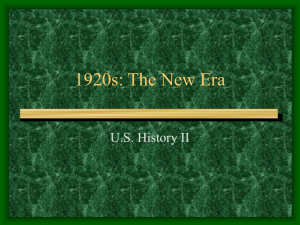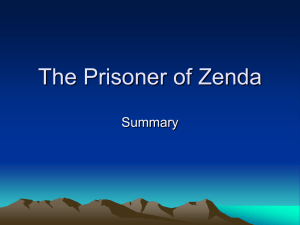My Last Duchess
advertisement
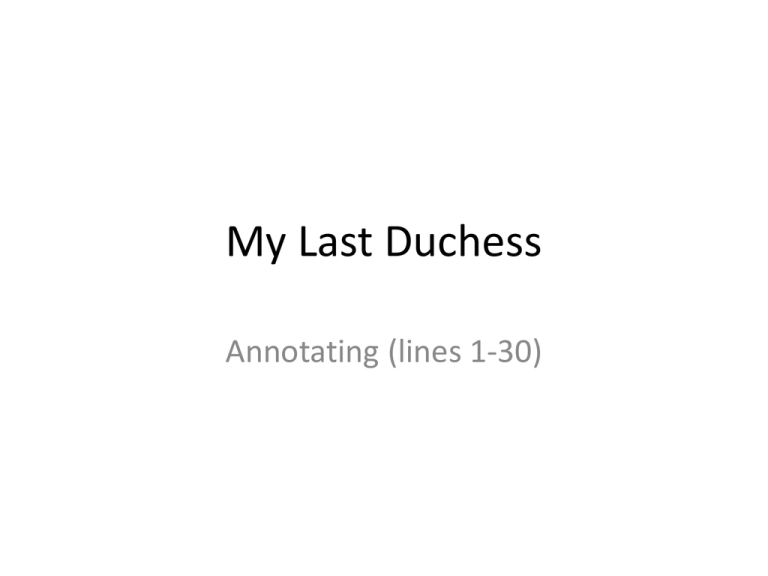
My Last Duchess Annotating (lines 1-30) • ‘My Last Duchess’ is a dramatic monologue by Robert Browning. The speaker is the Duke of Ferrara, who is showing a courier around the art in his house. The Count’s courier is meeting the Duke to discuss the Duke’s proposed marriage to the Count’s daughter. The Duke shows the emissary the portrait of his last Duchess, making it quite clear how he expects his next Duchess to behave. • The poem is preceded by the word Ferrara:, indicating that the speaker is most likely Alfonso II d'Este, the fifth Duke of Ferrara (1533–1598) who, at the age of 25, married Lucrezia di Cosimo de' Medici, 14-year-old daughter of Cosimo I de' Medici, Grand Duke of Tuscany, and Eleonora di Toledo. • Lucrezia was not well educated, and the Medicis' status could be termed "nouveau riche" in comparison with that of the venerable and distinguished Este family. The Duke's remark regarding his gift of a "nine-hundred-years-old name" clearly indicates that he considered his bride beneath him socially. She came, however, with a sizeable dowry. The couple married in 1558. He then abandoned her for two years before she died on April 21, 1561, at age 17. There was a strong suspicion of poisoning. • The Duke then sought the hand of Barbara, eighth daughter of the Holy Roman Emperor Ferdinand I and Anna of Bohemia and Hungary and the sister of the Count of Tyrol, Ferdinand II.[2] The count was in charge of arranging the marriage; the chief of his entourage, Nikolaus Madruz, a native of Innsbruck, was his courier. Madruz is presumably the silent listener in the poem. • The other characters named in the poem, painter Frà Pandolf and sculptor Claus of Innsbruck, are fictional. This is the first wife of the Duke of Ferrara – often believed to be the stimulus for Browning’s ‘My Last Duchess’. First Section • ‘That’s my last Duchess painted on the wall, looking as if she were alive.’ The Duke shows no remorse or sadness about his dead wife but is more interested in discussing the life-like qualities of the painting. He appears more interested in the painting than the person. This implies that the Duke wanted the Duchess as another beautiful object to add to his prestige. • One of the ways the Duke tries to impress people is by boasting about his possessions and the famous artists who have worked for him. • ‘I call that piece a wonder, now: Fra Pandolf’s hands Worked busily a day, and there she stands’ • ‘Will’t please you sit and look at her? I said’ • Notice how the Duke is encouraging the courier to sit in his presence – ultimately placing himself, physically, lower than the Duke. • ‘For never read Strangers like you that pictured countenance The depth and passion of its earnest glance, But to myself they turned’ - Speaking of the Duchess, he wants her to himself The Duke keeps the portrait behind a curtain The aside ‘since none puts by The curtain I have drawn for you, but I) ‘ Shows his urge to have control over his wife. In contrast to the Duchess’s behaviour, described later, the Duke has now turned her into the beautiful object he wanted her to be. The portrait (by the famous painter) adds to his status and is totally under his control. Only HE may look at her. • Lines 11-15 the Duke is speaking to the courier and pre-empting his question. Why is the Duchess smiling like that? • Shows the Duke is a bit touchy about this question – while we can suppose the Duke suspected something fishy going on between the painter and his wife, we MUST consider the most important point. The fact that the Duchess, his wife, dared to take a compliment from someone so far beneath her. • ‘”such stuff was courtesy, she thought, and cause enough For calling up that spot of joy.” The Duchess’s blush in the portrait was not as a result of looking at her husband, as the Duke would have expected, but from compliments given by the painter. Consider the word choice in line 19…how does this create a negative feeling towards the Duke? • The Duke is not impressed by the Duchess’s behaviour to those inferior to her rank. • ‘She had A heart…how shall I say?...too soon made glad, Too easily impressed; she like whate’er She looked on, and her looks went everywhere’ While this could be considered to mean she was unfaithful, remember this is from the egotistical, rank obsessed Duke. Analysing the points • Ellipsis is used effectively to suggest pause in the Duke’s thoughts. Due to the content we can assume that he is pausing to make it seem that this is just occurring to him when, in fact, this has irritated him. • He furthers this with the list of everything that “impressed” her. • Word choice “white mule” – suggesting her stallion is not a quality beast/suggesting she is inferior • The Duke feels the Duchess should have devoted herself entirely to him. Although she was pleasant to him, this was not enough. His pride demanded that she should constantly show gratitude to him for the great honour he had bestowed on her through marriage. • ‘Twas all one! My favour at her breast, The bough of cherries some officious fool Broke in the orchard for her, the white mule She rode with round the terrace – all and each Would draw from her alike the approving speech Or blush, at least.’ What is the Duke saying here? Lines 31-33 • “as if she ranked my gift of a nine-hundred-years-old-name with anybody’s gift.” • Describing his marriage as a ‘gift’ to his wife – how does he view himself? • Distinction between himself and “anybody” – how does he view himself? • Detail of 900 years – sees his heritage as a passport to superiority • From lines 34-43, the Duke is asking if the Duchess is to blame – if he had told her…perhaps she would have known that she was irritating him. But he shouldn’t HAVE to tell her. • “I choose Never to stoop.” Enjambment used to great effect here – placing emphasis on “choose” – it is all in the Duke’s hands, he has the power. Word choice of “stoop” shows that he feels it would belittle him to suggest improvements to his wife. He should HAVE to. Assonance – repeated vowel sound – puts emphasis on the words and allows the reader to imagine the ______ tone. Look at the section in speech marks • “Just this or that…the mark” • Is there anything in this section that you could analyse to suggest the Duke’s personality? Suggest the central concern/theme? Look at section from ‘This grew…as if alive.’ • Note the structure of these lines – impact? • Why has Browning chosen to repeat the Duke’s line again of “as if alive”? • Why didn’t the Duke say she was killed? Why did he express her passing in such a polite fashion? How is the reader aware of the Duke’s feelings towards his new wife? • From the language of the final ten lines how is this clarified to us? What is the significance of the statue at the end? • What could it be seen to represent? • How? • Why has Browning chosen to end his poem with this image? • What is the significance of the final line? Why has Browning used this to end his poem?

